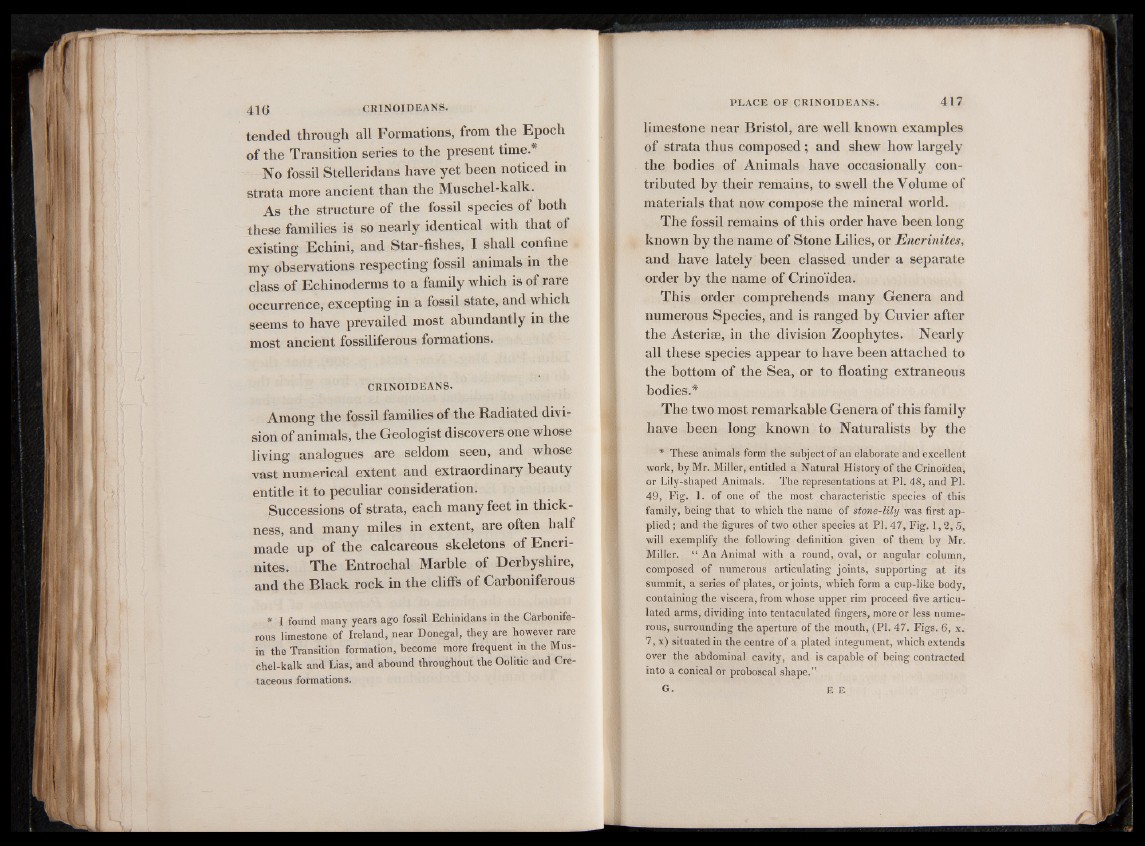
tended through all Formations, from the Epoch
of the Transition series to the present time.*
No fossil Stelleridans have yet been noticed in
strata more ancient than the Muschel-kalk.
As the structure of the fossil species of both
these families is so nearly identical with that of
existing Echini, and Star-fishes, I shall confine
my observations respecting fossil animals in the
class of Echinoderms to a family which is of rare
occurrence, excepting in a fossil state, and which
seems to have prevailed most abundantly in the
most ancient fossiliferous formations.
CRINOIDEANS.
Among the fossil families of the Radiated division
of animals, the Geologist discovers one whose
living analogues are seldom seen, and whose
vast numerical extent and extraordinary beauty
entitle it to peculiar consideration.
Successions of strata, each many feet in thickness,
and many miles in extent, are often half
made up of the calcareous skeletons of Encri-
nites. The Entrochal Marble of Derbyshire,
and the Black rock in the cliffs of Carboniferous
* I found many years ago fossil Echinidans in the Carboniferous
limestone of Ireland, near Donegal, they are however rare
in the Transition formation, become more frequent in the Muschel
kalk and Lias, and abound throughout the Oolitic and Cretaceous
formations.
limestone near Bristol, are well known examples
of strata thus composed; and shew how largely
the bodies of Animals have occasionally contributed
by their remains, to swell the Volume of
materials that now compose the mineral world.
The fossil remains of this order have been long
known by the name of Stone Lilies, or Encrinites,
and have lately been classed under a separate
order by the name of Crinoidea.
This order comprehends many Genera and
numerous Species, and is ranged by Cuvier after
the Asterise, in the division Zoophytes. Nearly
all these species appear to have been attached to
the bottom of the Sea, or to floating extraneous
bodies.*
The two most remarkable Genera of this family
have been long known to Naturalists by the
* These animals form the subject of an elaborate and excellent
work, by Mr. Miller, entitled a Natural History of the Crinoidea,
or Lily-shaped Animals. The representations at PI. 48, and PL
49, Fig. 1. of one of the most characteristic species of this
family, being that to which the name of stone-lily was first applied
; and the figures of two other species at PL 47, Fig. 1 ,2 ,5 ,
will exemplify the following definition given of them by Mr.
Miller. “ An Animal with a round, oval, or angular column,
composed of numerous articulating joints, supporting at its
summit, a series of plates, or joints, which form a cup-like body,
containing the viscera, from whose upper rim proceed five articulated
arms, dividing into tentaculated fingers, more or less numerous,
surrounding the aperture of the mouth, (PL 47. Figs. 6, x.
7, x) situated in the centre of a plated integument, which extends
over the abdominal cavity, and is capable of being contracted
into a conical or proboscal shape.”
G. E E